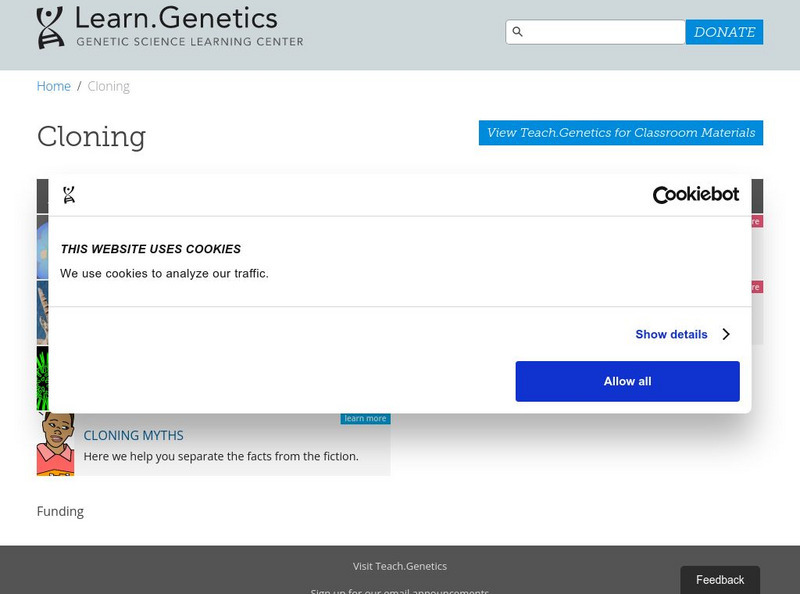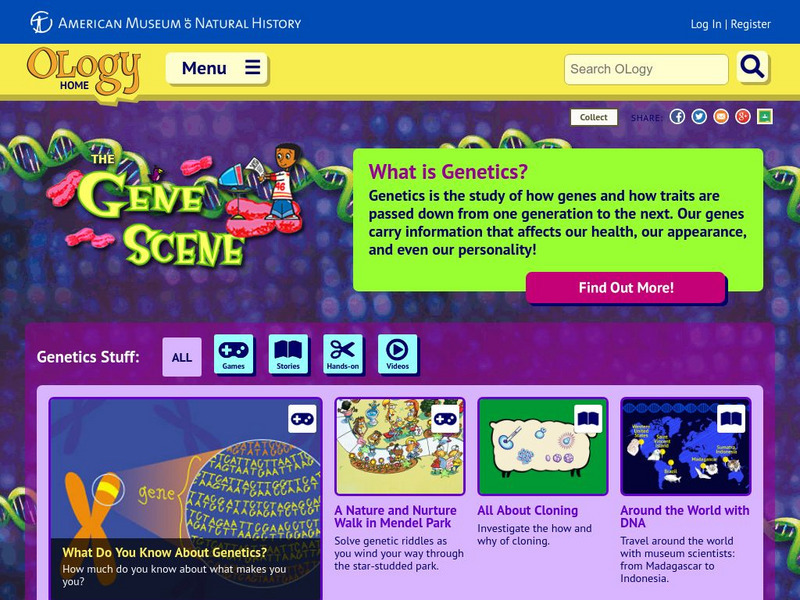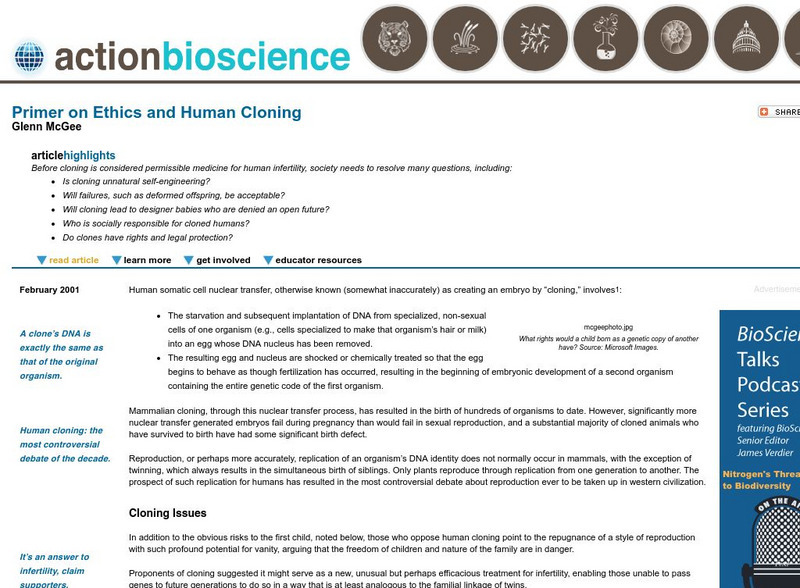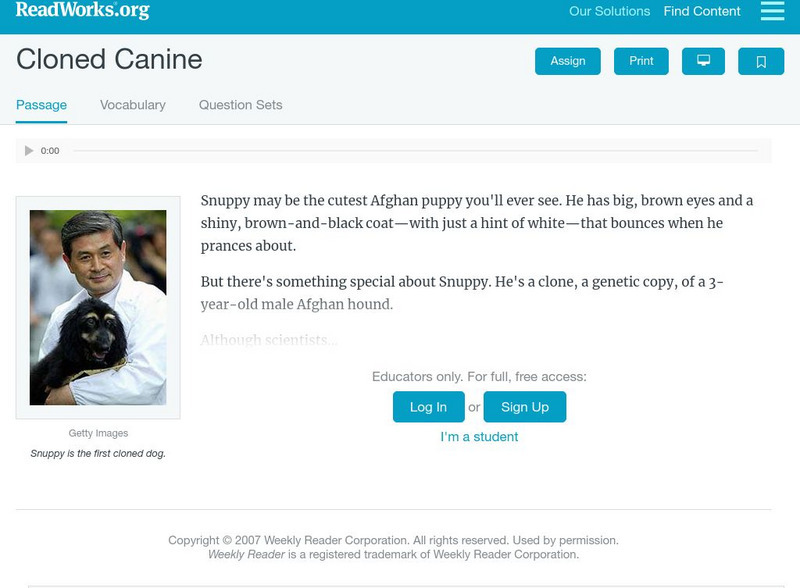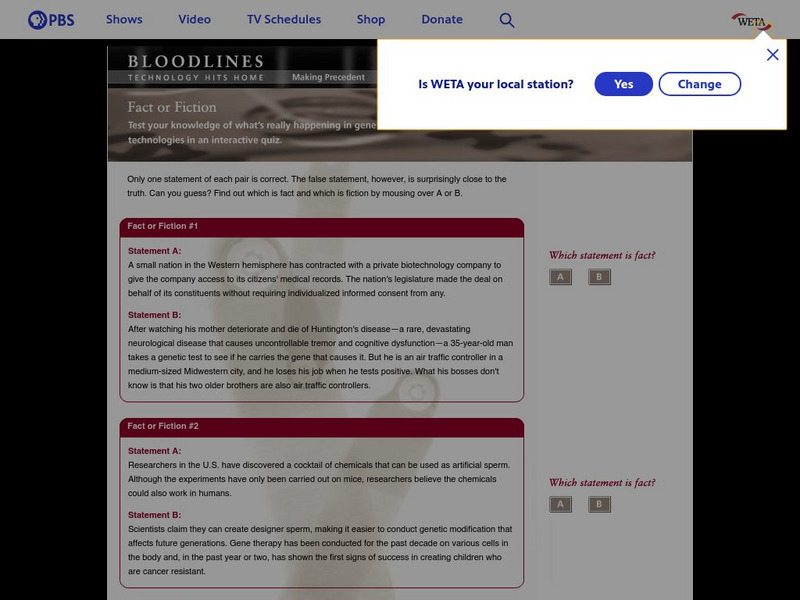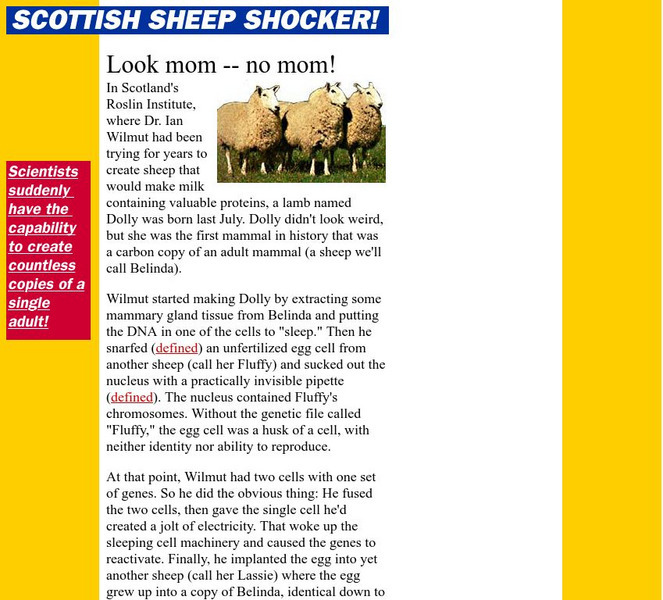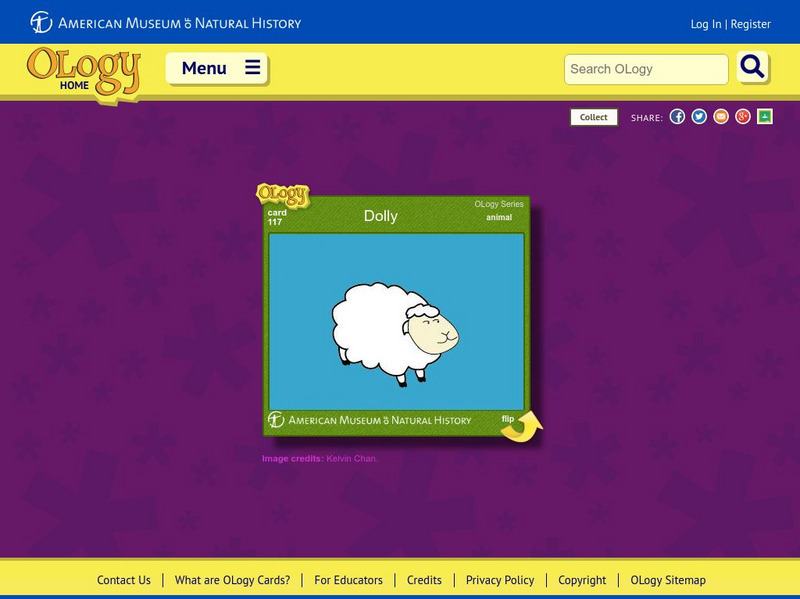Hi, what do you want to do?
eSchool Today
E School Today: Your Cool Facts and Tips on Genetic Engineering
Explains a basic concept in genetic engineering, i.e., the genetic modification of living things. Describes how it is done, how it differs from cloning, the benefits it offers, and the concerns people have about this practice.
Other
Eureka Science: Genetic Engineering
Explanation of how genetic engineering works. Analogy with molecular scissors cutting a "sentence" of DNA. Has nice animations.
PBS
Pbs Learning Media: On Human Cloning
Three cloning experts share their opinions of cloning in these interviews from NOVA: "18 Ways to Make a Baby."
Annenberg Foundation
Annenberg Learner: Applied Genetic Modification
Explore practical uses of genetic engineering techniques to generate a plant that produces a hepatitis B protein for potential vaccine use. Examine the use of restriction enzymes for cloning and plasmid mapping.
CK-12 Foundation
Ck 12: Life Science: Cloning
[Free Registration/Login may be required to access all resource tools.] Cloning is the process of creating an exact replica of an organism. The clone's DNA is exactly the same as the parent's DNA. Bacteria and plants have long been able...
University of Utah
University of Utah: Genetic Science Learning Center: Cloning in Focus
This group of pages comprehensively covers the topic of cloning. There is an interactive section about how it's done, some history of cloning technology, important issues in cloning, and even an interactive quiz.
Other
Eureka Science: Cloning
Read this short article to find out about the history of cloning and genetic engineering. Continue on to the next page to find out how cloning is done. Simple terms and fun animations make it easy to read.
University of Utah
University of Utah: Learn Genetics: Click and Clone
Practice the steps of cloning in this interactive animation. Using what you know about somatic cell nuclear transfer, your mission is to create a genetically identical clone of Mimi, a brown female mouse. You'll answer a few questions at...
BiologyWise
Biology Wise: The Pros and Cons of Cloning
Discusses the positive and negative aspects and repercussions of genetic cloning.
Cold Spring Harbor Laboratory
Dna Interactive: Chronicles
By looking at the history of genetic engineering, this site hopes to show where eugenics has gone wrong and where we have an opportunity to make it right.
PBS
Pbs Bloodlines: Technology Hits Home
This site is a must see for any lesson or unit on biotechnology! It is a companion to the PBS video "Bloodlines: Technology Hits Home," although it can certainly be used without the video. It's a fantastic site that will challenge...
Science Education Resource Center at Carleton College
Serc: Human Cloning: Is It Biological Plagiarism?
This lesson guides students to learn the science behind cloning, explore the benefits and consequences of human cloning, and communicate their knowledge and points of view.
American Museum of Natural History
American Museum of Natural History: O Logy: Genetics
This site from American Museum of Natural History focuses on Genetics. It defines genetics and provides links to games, stories, videos, and hands-on activities on the topic.
Other
Tech Museum of Innovation: Cloning
As part of the online exhibit on Genetics from the Tech Museum of Innovation, this site deals with cloning and specifically cloning research and details on genetics.
American Institute of Biological Sciences
Action Bioscience: Primer on Ethics and Human Clonings
This artical evaluates the ethics involved with cloning humans. Issues such as legal rights and protection and determining whether it is unnatural self-engineering are addressed.
Mocomi & Anibrain Digital Technologies
Mocomi: What Is Cloning?
Defines cloning and how it works. Learn about the cloning of Dolly the sheep and other interesting facts.
PBS
Pbs Bloodlines: Making Precedent
Excellent site where students are challenged to read several case studies and make choices about what they would do in the situation. After they choose they are presented with some of the consequences that their decision may produce in...
Read Works
Read Works: Cloned Canine
[Free Registration/Login Required] An informational text about the first scientists to successfully clone a dog. A question sheet is available to help students build skills in reading comprehension.
BBC
Bbc: Gcse Bitesize: Mitosis and Cell Specialisation
This lesson focuses on cloning. Plants can make identical copies of themselves by asexual reproduction, for example by tubers and runners. Humans have been cloning plants for years and have recently started to develop techniques to clone...
PBS
Pbs: Fact of Fiction
At this site from PBS you can challenge yourself with this quiz to see if you know what is true and what is false in genetic and reproductive technology. You'll be surprised by some of the things that we are currently able to do with...
University of Wisconsin
The Why Files: Scottish Sheep Shocker
Simplified and irreverent explanation of how Dolly was cloned. Includes a simple timeline of cloning technology. Some good information behind the humor.
American Museum of Natural History
American Museum of Natural History: Dolly O Logy Card
Dolly the sheep, the first mammal to be cloned with DNA from an adult cell, is the subject of this interactive OLogy card. Flip the card to find questions and answers, fast facts, and other bite-size pieces of information that focus your...
The Association of the British Pharmaceutical Industry
Abpi: Biotechnology
Students read through a complete, interactive lesson on biotechnology. An activity at the end allows students to research and present arguments for or against statements about the ethics of gene therapy and gene manipulation.
Other
Canadian Institutes of Health Research: Human Stem Cell Research [Pdf]
A recent study in which the authors examined the health and ethical issues related to human stem cell research. As a result of this study, Canada did allow human stem cell research to proceed. The report is in PDF format.








